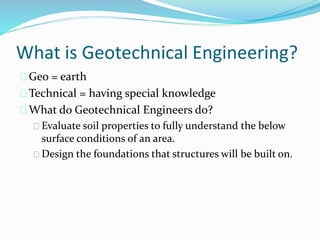Geotheta for Dummies
Geotheta for Dummies
Blog Article
Excitement About Geotheta
Table of ContentsThe Definitive Guide for GeothetaSome Of GeothetaGeotheta Things To Know Before You Get ThisNot known Details About Geotheta The Best Strategy To Use For Geotheta

They carry out site examinations, gather examples, do laboratory tests, and evaluate data to evaluate the suitability of the ground for construction jobs - Geotechnical Engineers. Based upon their findings, geotechnical designers provide recommendations for structure layout, incline security, preserving structures, and reduction of geotechnical risks. They team up with various other professionals, such as architects, architectural designers, and building and construction teams, to guarantee that geotechnical factors to consider are incorporated right into the general project design and application
By analyzing the habits and buildings of soil and rock, they can determine possible geotechnical threats such as landslides, dirt settlement, or incline instability. Their knowledge assists avoid failings or crashes that might threaten lives and residential or commercial property. Below are some comprehensive responsibilities and duties of a geotechnical engineer: Site Examination: Geotechnical designers conduct website investigations to collect information on subsurface conditions.
They interpret the information to comprehend the residential properties and habits of the soil and rock, including their toughness, leaks in the structure, compaction features, and groundwater conditions. Geotechnical Analysis and Layout: Geotechnical designers assess the data collected during site examinations to evaluate the stability and suitability of the site for building and construction jobs. They execute geotechnical computations and modeling to evaluate elements such as bearing capability, settlement, slope stability, side planet stress, and groundwater circulation.
Some Ideas on Geotheta You Need To Know
Foundation Design: Geotechnical designers play a crucial role in creating structures that can securely sustain the designated framework. They assess the soil problems and load needs to identify the appropriate structure type, such as shallow foundations (e.g., grounds), deep structures (e.g (https://old.bitchute.com/channel/GgOXLypkqwPa/)., heaps), or specialized techniques like soil renovation. They consider elements such as settlement limits, bearing capacity, and soil-structure communication to create optimum foundation styles
They evaluate construction plans, monitor site activities, and conduct area examinations to validate that the layout recommendations are adhered to. If unexpected geotechnical issues emerge, they evaluate the situation and give recommendations for removal or changes to the style. Danger Analysis and Mitigation: Geotechnical engineers analyze geotechnical hazards and dangers connected with the project website, such as landslides, liquefaction, or soil disintegration.

Cooperation and Interaction: Geotechnical designers function closely with other experts entailed in a job, such as designers, structural designers, and building and construction groups. Effective interaction and collaboration are vital to incorporate geotechnical considerations right into the general job design and building procedure. Geotechnical engineers provide technical expertise, answer inquiries, and make sure that geotechnical needs are fulfilled.
The Single Strategy To Use For Geotheta
Here are some kinds of geotechnical designers: Structure Engineer: Structure engineers specialize in developing and assessing structures for frameworks. They examine the dirt problems, tons needs, and site features to establish one of the most ideal structure kind and design, such as superficial structures, deep foundations, or specialized techniques like pile structures.
They examine the factors influencing slope stability, such as soil properties, groundwater conditions, and slope geometry, and create strategies to avoid incline failures and reduce dangers. Earthquake Designer: Quake designers specialize in examining and making structures to endure seismic forces. They evaluate the seismic danger of a site, examine dirt liquefaction possibility, and create seismic layout criteria to guarantee the safety and security and durability of frameworks throughout earthquakes.
They execute area testing, gather examples, and assess the accumulated information to identify the soil properties, geologic developments, and groundwater problems at a site. Geotechnical Instrumentation Engineer: Geotechnical instrumentation engineers concentrate on tracking and determining the actions of soil, rock, and frameworks. They install and preserve instrumentation systems that check aspects such as soil settlement, groundwater degrees, slope movements, and architectural displacements to examine performance and provide early warnings of possible problems.
Some Ideas on Geotheta You Need To Know
They conduct examinations such as triaxial tests, loan consolidation tests, straight shear tests, and leaks in the structure tests to gather information for geotechnical evaluation and design. Geosynthetics Engineer: Geosynthetics designers focus on the design and application of geosynthetic materials, such as geotextiles, geogrids, and geomembranes. They utilize these materials to improve soil security, enhance slopes, supply drainage options, and control disintegration.
They have a tendency to be investigative people, which indicates they're intellectual, reflective, and inquisitive. They are interested, systematic, logical, logical, and sensible. A few of them are likewise social, indicating they're kind, charitable, participating, individual, caring, handy, empathetic, skillful, and friendly. Does this seem like you? Take our totally free career test to learn weblink if geotechnical engineer is just one of your top career matches.
In the office atmosphere, geotechnical designers utilize specialized software application devices to do calculations, develop layouts, and examine information. They prepare records, review task specifications, communicate with customers and group participants, and coordinate job tasks. The office setup provides a helpful setting for study, evaluation, and partnership with other professionals included in the project.
Excitement About Geotheta
They often see task sites to perform website examinations, examine geotechnical problems, and gather data for analysis. These check outs involve traveling to various areas, in some cases in remote or difficult terrains. Geotechnical engineers may do soil tasting, conduct tests, and monitor building tasks to ensure that the geotechnical elements of the task are being implemented appropriately.
Geotechnical designers likewise operate in specialized geotechnical laboratories. In these facilities, they conduct experiments, perform tests on soil and rock examples, and evaluate the design residential properties of the products. Geotechnical laboratory designers work extensively in these environments, dealing with testing devices, operating instruments, and tape-recording data. They collaborate with other research laboratory team to ensure exact and reputable screening results.
Report this page